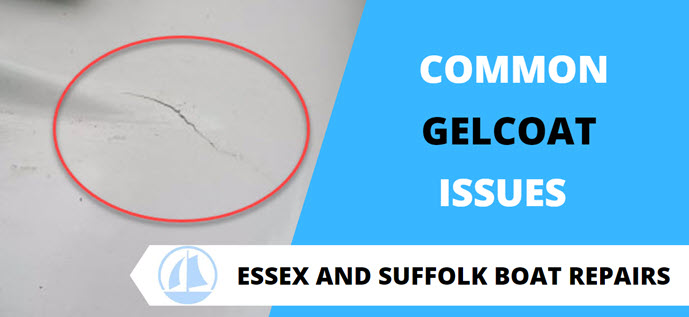Welcome to todays post where I’m going to go over some common gelcoat issues that all boat owners will face at some point, hopefully you will gain sufficient knowledge in order for you to feel happy to tackle some issues yourself.
Of course, we are here should you need to reach out for some additional advise.
Remember, your boat is more than just a vessel; it’s a statement of your passion for the water. Maintaining its appearance and structural integrity is not just about pride; it’s a crucial aspect of responsible boat ownership.
At the forefront of this protection is the unsung hero of your boat’s exterior – the gelcoat. Often overlooked, yet indispensable, the gelcoat plays a dual role in preserving both the aesthetics and structural robustness of your watercraft.
Preserving Aesthetics:
Picture this: the sun dancing on the water, a gentle breeze, and your boat gliding through the waves. Now, envision your boat with a faded, weather-beaten exterior.
The gelcoat, acting as the outer layer, shields your boat from the harsh effects of UV rays, saltwater, and atmospheric contaminants. It’s the guardian that preserves that showroom shine and vibrant colour, ensuring your boat remains a head-turner on every voyage.
Safeguarding Structural Integrity:
Beneath the glossy surface lies the structure that keeps your boat seaworthy. The gelcoat isn’t just about looks; it’s a protective barrier that shields the fibreglass hull from water intrusion, osmosis, and potential damage.
Think of it as the armour that defends your boat against the elements, maintaining its integrity for countless voyages.
Why Understanding Gelcoat Matters:
Knowing the common issues that plague gelcoat and how to address them is akin to understanding the language of your boat. It empowers you to take proactive steps, ensuring that your vessel not only looks impeccable but remains structurally sound.
As a boat owner, being well-versed in the language of gelcoat allows you to detect issues early on and take corrective measures, preventing minor blemishes from turning into major headaches.
Empowering Boat Owners:
This blog aims to be your guide in navigating the seas of gelcoat care. We’ll delve into the common issues that boat owners frequently encounter, unravelling the mysteries behind fading, cracking, blistering, and discoloration.
Moreover, we’ll equip you with step-by-step solutions for DIY repairs, empowering you to play an active role in the maintenance of your boat.
Whether you’re a seasoned sailor or a novice enthusiast, understanding and caring for your boat’s gelcoat is an investment in the longevity and allure of your aquatic companion.
Join us on this journey as we explore the nuances of gelcoat care and unveil the secrets to keeping your vessel in impeccable condition. After all, a well-cared-for boat is not just a possession; it’s a testament to the love of the open water.
Table of Contents
Section 1: What is Gelcoat?
The gleaming exterior of your fibreglass boat owes its brilliance to a critical component called gelcoat. Often underestimated but undeniably crucial, gelcoat is the outer layer that not only defines the aesthetics of your vessel but serves as a frontline defender against the relentless forces of nature.
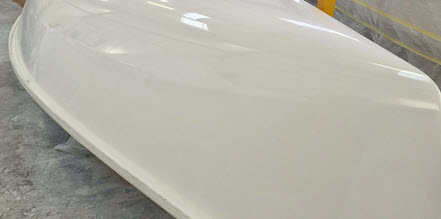
1.1 Definition of Gelcoat:
Gelcoat is a specialized, pigmented resin that forms the outermost layer of a fibreglass boat’s hull. Applied during the boat manufacturing process, this compound is not just about adding colour; it is an integral part of the boat’s structure. Gelcoat creates a smooth, glossy surface that enhances the visual appeal of the vessel while offering protection to the underlying fibreglass.
1.2 The Protective Shield:
The role of gelcoat goes beyond aesthetics; it acts as a formidable shield, safeguarding the boat from the harsh elements it encounters on every journey:
- UV Radiation: The sun’s ultraviolet rays can be harsh on any surface, causing colors to fade and materials to deteriorate. Gelcoat acts as a UV-resistant barrier, preventing the fibreglass beneath from succumbing to sun damage.
- Water Resistance: In the aquatic environment, exposure to water is inevitable. Gelcoat’s water-resistant properties prevent water from infiltrating the fibreglass matrix. This is critical because prolonged water exposure can lead to osmotic blistering, compromising the structural integrity of the boat.
- Environmental Contaminants: Whether it’s salt spray, air pollution, or general debris in the atmosphere, the gelcoat forms a protective barrier against these environmental contaminants. This not only preserves the boat’s appearance but also prevents corrosive damage.
1.3 The Dual Purpose: Aesthetics and Protection:
Gelcoat is not a mere cosmetic layer; it’s a carefully engineered combination of resin and pigment designed to offer both visual allure and functional durability. Its glossy finish reflects the sun’s rays, making your boat a beacon on the water, while its protective properties ensure that the fibreglass structure remains resilient against the challenges posed by the marine environment.
In the subsequent sections, we will delve into the intricacies of gelcoat care, exploring common issues and providing solutions to empower boat owners in the maintenance of this vital component. Understanding gelcoat is the first step towards preserving the beauty and integrity of your fibreglass boat, ensuring that it continues to grace the waters with both style and resilience.
Section 2: Common Gelcoat Issues
As resilient as gelcoat is, it’s not impervious to the wear and tear inflicted by time and the marine environment. Understanding common gelcoat issues is essential for boat owners, as it empowers them to address problems early on and prevent them from escalating. In this section, we’ll explore some prevalent gelcoat issues and their implications:
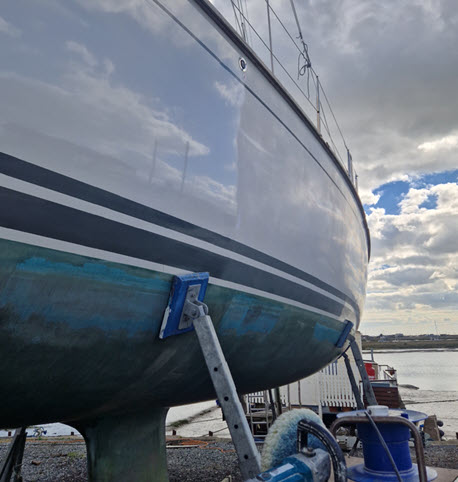
2.1 Fading and Chalking:
Causes of Gelcoat Fading and Chalking:
- UV Exposure: Prolonged exposure to sunlight breaks down the polymers in the gelcoat, leading to a loss of colour vibrancy.
- Oxidation: The reaction of oxygen with the gelcoat’s components can result in a chalky appearance.
- Environmental Factors: Saltwater, pollutants, and atmospheric contaminants contribute to the breakdown of the gelcoat.
Effects on the Boat’s Appearance and Longevity:
- Dull Aesthetics: Fading diminishes the vibrant appearance of the boat, impacting its overall visual appeal.
- Structural Implications: While fading primarily affects aesthetics, severe cases may indicate deeper issues, potentially compromising the gelcoat’s protective capabilities.
2.2 Cracks and Spider Cracks:
Reasons Behind the Development of Cracks:
- Stress and Impact: High-stress areas, collisions, or impacts with hard objects can lead to the development of cracks.
- Aging and Flexing: Over time, the boat’s natural flexing can contribute to the formation of surface-level cracks.
Differentiating Between Surface-level Cracks and Deeper Structural Issues:
- Surface-level Cracks: Generally cosmetic, these cracks are confined to the gelcoat and don’t compromise the structural integrity.
- Deeper Structural Issues: Cracks extending into the fibreglass may signal structural problems, requiring prompt attention to prevent further damage.
2.3 Blistering:
Explanation of Gelcoat Blisters and How They Form:
- Osmosis: Water infiltrates the fibreglass through microscopic openings, leading to the formation of blisters.
- Chemical Reactions: Residual chemicals in the manufacturing process or environmental exposure can contribute to blister formation.
Impact on the Hull and Potential Water Ingress Issues:
- Hull Disfiguration: Blisters can cause bulges on the hull, affecting the boat’s hydrodynamics.
- Potential Water Ingress: If left untreated, blisters may compromise the gelcoat’s water-resistant properties, allowing water to penetrate the fibreglass.
2.4 Stains and Discoloration:
Common Causes of Stains and Discoloration on Gelcoat:
- Metallic Corrosion: Contact with metal fittings or components can lead to rust stains.
- Organic Growth: Algae, mould, or mildew can cause unsightly discoloration.
- Chemical Exposure: Contact with certain chemicals or fuels can result in stains.
Tips on Identifying and Addressing Different Types of Stains:
- Visual Inspection: Careful examination helps identify the nature of the stain.
- Appropriate Cleaning: Use specific cleaners or treatments based on the type of stain to avoid damaging the gelcoat.
Understanding these common gelcoat issues is the first step towards effective maintenance. In the following sections, we’ll provide actionable steps and solutions for DIY repairs, helping boat owners keep their vessels in top condition.
Section3: DIY Gelcoat Repairs: Step-by-Step Solutions:
Gelcoat issues are a common concern for boat owners, but with the right materials and a bit of know-how, many problems can be addressed through DIY repairs. Here, we’ll guide you through step-by-step solutions for some of the most common gelcoat issues:
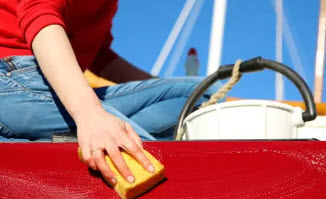
3.1 Materials Needed:
Before diving into the repairs, gather the following materials. Remember, the quality of the products used is crucial for effective and lasting results:
- Marine-grade Gelcoat
- Gelcoat colour matching kit
- Gelcoat hardener
- Fibreglass cloth or mat
- Acetone or fibreglass surface cleaner
- Fine-grit sandpaper (320 to 600 grit)
- Polishing compound
- Marine wax or sealant
- Gelcoat filler for cracks
- Putty knife
- Mixing cups and sticks
- Safety gear (gloves, safety glasses)
3.2 Fading and Chalking Repair:
Step-by-Step Instructions:
- Clean the Surface: Thoroughly clean the faded or chalked area with a fibreglass surface cleaner or acetone to remove contaminants.
- Compounding: Apply a high-quality marine-grade compound using a buffer or by hand. Work in small sections, applying even pressure. Buff until the gelcoat’s original colour begins to emerge.
- Polishing: Follow up with a marine-grade polishing compound to further enhance the shine. Use a clean, soft cloth or buffer for this step.
- Seal the Surface: Finish the process by applying a marine wax or sealant to protect the restored gelcoat from future UV damage.
Recommendations:
- Use a reputable marine-grade compound and polishing compound for optimal results.
- Follow the manufacturer’s instructions for each product.
3.3 Crack Repair:
Instructions for Surface-level Cracks:
- Clean and Sand: Clean the cracked area and lightly sand the edges using fine-grit sandpaper.
- Apply Gelcoat Filler: Use a gelcoat filler that matches your boat’s colour. Apply it to the crack using a putty knife, ensuring a smooth finish.
- Sand and Blend: Once the filler is cured, sand the repaired area gently to blend it with the surrounding gelcoat.
Guidance on Deeper Cracks:
- Assessment: If the crack extends into the fibreglass, assess the severity. Surface-level repairs are feasible for small cracks, but deeper issues may require professional attention.
- Professional Assistance: Consult a marine repair professional for deeper cracks to prevent structural complications.
3.4 Blister Repair:
Steps for Addressing Gelcoat Blisters:
- Dry the Blisters: Allow the affected area to dry completely. This may involve leaving the boat out of the water for a period.
- Sand the Blisters: Gently sand the blistered area to remove the damaged gelcoat, exposing the fibreglass beneath.
- Apply New Gelcoat: Mix a fresh batch of gelcoat with hardener and apply it to the sanded area. Smooth the surface with a putty knife.
- Sanding and Finishing: Once cured, sand the repaired area to achieve a smooth finish. Follow up with compounding and polishing for a seamless look.
Cautionary Notes:
- Consult a professional for extensive blistering issues to avoid potential complications.
3.5 Stain Removal:
DIY Solutions for Common Stains:
- Identify the Stain: Determine the type of stain (rust, algae, etc.) to choose the appropriate cleaning method.
- Rust Stains: Use a specialized rust stain remover, following the product instructions.
- Algae and Organic Stains: Create a mixture of white vinegar and water or use a marine-grade cleaner. Apply the solution and gently scrub the stain.
Warnings:
- Avoid abrasive methods, such as using steel wool, as they can damage the gelcoat.
- Test any cleaner on a small, inconspicuous area before applying it to the entire stain.
By following these step-by-step solutions and utilizing high-quality materials, boat owners can tackle common gelcoat issues and contribute to the longevity and aesthetic appeal of their vessels. Remember, if in doubt or if the issue is extensive, seeking professional advice is always a wise decision.
Section 4: When to Seek Professional Help:
While DIY gelcoat repairs are effective for many common issues, there are situations where the expertise of a professional becomes essential. Recognizing when to seek professional help is crucial to ensuring the structural integrity and overall well-being of your boat.
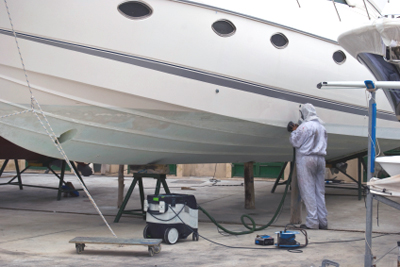
Here are clear signs indicating that it’s time to consult a professional for gelcoat repairs:
4.1 Clear Signs for Professional Gelcoat Repair:
- Extensive Structural Damage:
- Indicators: Large cracks extending beyond the gelcoat, visible hull distortions, or significant damage affecting the fiberglass.
- Why Professional Help: Structural damage requires a comprehensive assessment and specialized repair techniques that may be beyond the scope of DIY repairs.
- Widespread Blistering:
- Indicators: Numerous blisters covering a considerable area of the hull, especially if they are deep or compromising the gelcoat’s water-resistant properties.
- Why Professional Help: Extensive blistering may require more intricate repairs, including hull drying and advanced techniques to prevent recurrence.
- Gelcoat Delamination:
- Indicators: Separation of the gelcoat layer from the underlying fiberglass, often resulting in a hollow or drum-like sound when tapped.
- Why Professional Help: Delamination signifies a loss of bond between layers, necessitating professional intervention to reattach the gelcoat securely.
- Persistent Leaks or Water Ingress:
- Indicators: Repeated water intrusion despite attempted DIY repairs, leading to damp interiors or persistent leaks.
- Why Professional Help: Identifying and rectifying the source of leaks can be complex and may require specialized equipment for a thorough assessment.
- Expert Color Matching Needed:
- Indicators: When precise colour matching is crucial, especially for high-profile areas, such as those visible above the waterline.
- Why Professional Help: Achieving an exact colour match requires experience, specialized tools, and access to a wide range of gelcoat pigments.
4.2 Importance of Consulting a Professional for Structural Issues or Extensive Damage:
- Preserving Structural Integrity:
- Why Professional Help: Structural issues, such as deep cracks or delamination, can compromise the boat’s integrity. Professionals are trained to assess the extent of the damage and implement appropriate repairs to ensure the vessel remains seaworthy.
- Preventing Further Damage:
- Why Professional Help: Neglecting extensive damage can lead to further deterioration and escalating repair costs. Professionals can address issues comprehensively, preventing secondary problems from arising.
- Specialized Techniques and Materials:
- Why Professional Help: Repairing extensive damage often requires specialized techniques and materials that may not be readily available or familiar to DIY enthusiasts. Professionals have access to industry-grade products and expertise.
- Ensuring Lasting Repairs:
- Why Professional Help: While DIY repairs are effective for minor issues, professional repairs offer a level of precision and durability needed for extensive damage. Professionals are equipped to provide lasting solutions that meet industry standards.
- Navigating Complex Repairs:
- Why Professional Help: Certain repairs, such as blister treatments or structural reinforcements, require a deep understanding of fiberglass technology. Professionals bring knowledge and experience to navigate complex repairs successfully.
In conclusion, while DIY repairs can handle many gelcoat issues, there are scenarios where the expertise of a professional becomes indispensable. Recognizing the signs that warrant professional assistance ensures that your boat receives the care it needs to remain in top condition for years to come.
Conclusion
As we conclude our exploration of gelcoat care, it’s essential to recap the common issues faced by boat owners and the DIY solutions provided. Additionally, we want to emphasize the importance of regular inspections, proactive maintenance, and the invaluable role of professional assistance in dealing with complex gelcoat issues.
Recap of Common Gelcoat Issues and DIY Solutions:
From fading and chalking to cracks, blisters, and stains, gelcoat issues are an inevitable part of boat ownership. However, armed with the right knowledge and materials, many of these challenges can be effectively addressed through DIY solutions:
- Fading and Chalking: Compounding, polishing, and sealing can restore the gelcoat’s shine and protect it from further damage.
- Cracks: Surface-level cracks can be filled with a gelcoat filler, while deeper issues may require professional assessment.
- Blistering: Drying, sanding, and applying a new gelcoat layer can address blisters, with cautionary notes on when to seek professional help.
- Stains: DIY solutions using appropriate cleaners can effectively remove common stains, with warnings against abrasive methods that could harm the gelcoat.
By following these step-by-step solutions and using high-quality materials, boat owners can actively contribute to the longevity and aesthetic appeal of their vessels.
Encouragement for Regular Inspections and Maintenance:
Prevention is often the best cure, and this holds true for gelcoat care. Regular inspections of your boat’s exterior can help you identify potential issues before they escalate.
We encourage boat owners to incorporate routine maintenance into their schedule, checking for signs of fading, cracks, blisters, or stains. Timely attention to minor problems can save both time and resources in the long run, preserving the beauty and structural integrity of your boat.
Reminder of the Significance of Professional Assistance:
While DIY repairs are effective for many situations, there are instances where professional assistance is indispensable. Extensive structural damage, widespread blistering, or issues requiring precise colour matching often demand the expertise of a marine repair professional.
The investment in professional assistance ensures that your boat receives thorough assessments, specialized techniques, and lasting solutions, safeguarding it against further complications.
In the grand tapestry of boat ownership, gelcoat care is a thread that weaves aesthetics and structural integrity together.
By staying informed, conducting regular inspections, and knowing when to seek professional help, boat owners can navigate the seas with confidence, ensuring their vessels remain not just possessions, but enduring testaments to the love of the open water.
Now It’s Your Turn!

Embarking on a journey to maintain and care for your boat’s gelcoat is a shared endeavour among the maritime community. We invite you, our readers, to be part of this dialogue by sharing your own gelcoat repair experiences, insights, or questions.
Whether you’ve successfully tackled a challenging repair or have queries about a specific issue, your contributions enrich our collective knowledge and help fellow boat enthusiasts navigate the seas of gelcoat care.
Share Your Experiences: Have you overcome a particularly stubborn stain, mastered a flawless colour match, or triumphed over a gelcoat challenge? Your experiences could inspire and guide others facing similar situations. Share your stories, tips, or lessons learned in the comments section below.
Seeking Assistance? Have Questions? If you find yourself facing a gelcoat dilemma that goes beyond the scope of DIY solutions, or if you have questions about a specific issue, we’re here to help. My team of experienced professionals are ready to provide guidance and expert advice. Don’t hesitate to reach out:
You can do that here via the contact form
Our commitment is to assist you in navigating the complexities of gelcoat care, ensuring that your boat remains a source of pride and joy on every voyage. Together, let’s foster a community that shares knowledge, supports one another, and celebrates the enduring allure of the open water.
